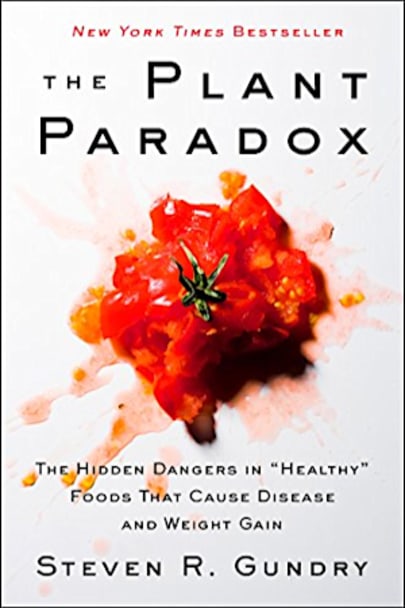“I read this book… it worked. My autoimmune disease is gone and I’m 37 pounds lighter in my pleather.” –Kelly ClarksonMost of us have heard of gluten—a protein found in wheat that causes widespread inflammation in the body. Americans spend billions of dollars on gluten-free diets in an effort to protect their health. But what if we’ve been missing the root of the problem? In The Plant Paradox, … Plant Paradox, renowned cardiologist Dr. Steven Gundry reveals that gluten is just one variety of a common, and highly toxic, plant-based protein called lectin. Lectins are found not only in grains like wheat but also in the “gluten-free” foods most of us commonly regard as healthy, including many fruits, vegetables, nuts, beans, and conventional dairy products. These proteins, which are found in the seeds, grains, skins, rinds, and leaves of plants, are designed by nature to protect them from predators (including humans). Once ingested, they incite a kind of chemical warfare in our bodies, causing inflammatory reactions that can lead to weight gain and serious health conditions.
At his waitlist-only clinics in California, Dr. Gundry has successfully treated tens of thousands of patients suffering from autoimmune disorders, diabetes, leaky gut syndrome, heart disease, and neurodegenerative diseases with a protocol that detoxes the cells, repairs the gut, and nourishes the body. Now, in The Plant Paradox, he shares this clinically proven program with readers around the world.
The simple (and daunting) fact is, lectins are everywhere. Thankfully, Dr. Gundry offers simple hacks we easily can employ to avoid them, including:
- Peel your veggies. Most of the lectins are contained in the skin and seeds of plants; simply peeling and de-seeding vegetables (like tomatoes and peppers) reduces their lectin content.
- Shop for fruit in season. Fruit contain fewer lectins when ripe, so eating apples, berries, and other lectin-containing fruits at the peak of ripeness helps minimize your lectin consumption.
- Swap your brown rice for white. Whole grains and seeds with hard outer coatings are designed by nature to cause digestive distress—and are full of lectins.
With a full list of lectin-containing foods and simple substitutes for each, a step-by-step detox and eating plan, and delicious lectin-free recipes, The Plant Paradox illuminates the hidden dangers lurking in your salad bowl—and shows you how to eat whole foods in a whole new way.
more



This will change your life.
There is no one-size-fits-all diet. Ever.
Dr Gundry has many brilliantly informative suggestions to make about the food we eat. His belief, based on his knowledge of the toxicity of lectins in many of the foods we eat, is very persuasive. His point about casein A-1 in milk, that many people are intolerant to, has been especially helpful. I buy only A-2 milk now – I’m even tempted, and will likely follow through, on making my own butter from the milk I buy, as I haven’t yet found a brand of butter made from A-2 milk. Cheese is available, not butter. Buying French or Italian A-2 organic butter may be available in New Zealand’s city supermarkets, but not in the rural sector in which I live.
As for acid-blockers – another useful insight, and one I knew a little of a few years ago. And now know a lot more. For which I am grateful. These PPIs did damage my microbiome, my GP prescribed them (not available over-the-counter in Australia, where I lived at the time) for fifteen years, not the recommended two weeks.
Eating fresh foods in season also makes sense to me. I’m not yet a convinced vegetarian, but I no longer buy meat from my supermarkets or butcher. Utterly convincing information on the pesticide sprayed non-food fed to cattle to fatten them for market, along with hormones and antibiotics – and PPIs(!) – turned me away from meat presented this way. We are able to buy wild game meat elsewhere.
The problem I have with Dr Gundry’s solution for unhealthy guts is the limitations. Plus, the cost. Prebiotics and probiotics are available in food such as yoghurt, nuts, seeds, berries, bananas, etc. I have no interest in buying his various formulas when I can eat these healthy additions in locally grown actual food. There is also the severe limitation on the types of food he includes in dietary suggestions. For sure, an increasing number of people around the world find it hard to digest gluten, including me. Even gluten-free flour can give me heartburn. But why would I want to purchase garlic or onion powder when I can grow my own garlic and onions? Ditto dried herbs, which lose their best flavour when dried, when I grow my own herbs?
What makes sense to me is a measured approach to assessing how my gut responds to each food. A slow task spread out over time. There is no one-size-fits-all diet that works for every person. There is only responsibility for our individual gut health. In the western world there is a lot of over-processed junk available in supermarkets, marketed by those with an interest in making money from our poor choices – food-like substances to be avoided. Dr Gundry’s diet, from my perspective, is a careful approach to beginning to reduce, and maybe eliminate, the “bad guys” in our microbiome, but it’s not a way to live for the rest of our lives.
Best health book I have read in my lifetime!
Amazing information, a great take on human evolution and our bodies’ needs as a result. At times too restrictive.
I thought the book was interesting about anew kind of diet
Lots of good information in an easy to read format
I enjoyed to examination of science, studies, history, and norms so that we can eat well to feel and live our best.
This is just what the Doctor Ordered!